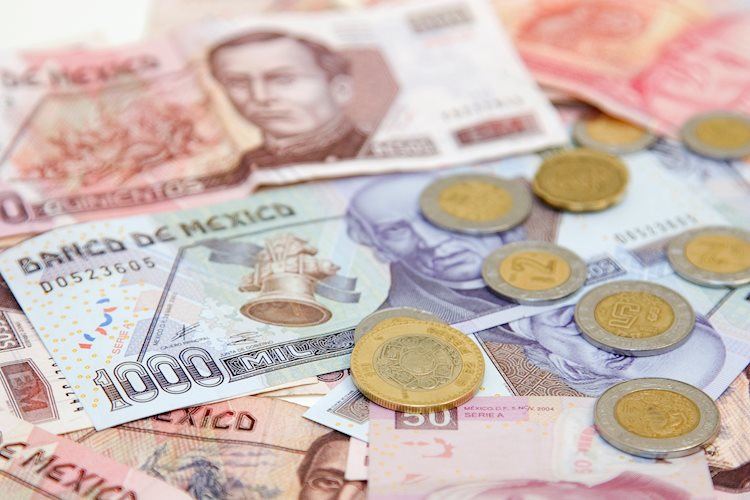- Mexican Peso gained 0.90% earlier on Friday but erased gains amid a weaker US Dollar.
- US Dollar Index hit a two-month high before retreating to 103.48, down 0.23% on Friday.
- China’s stimulus measures provided brief support to the Peso.
The Mexican Peso remained firm against the US Dollar on Friday yet erased earlier gains, which saw the emerging market currency appreciate over 0.90%. US economic data revealed during the week justified the Federal Reserve’s (Fed) gradual approach to easing policy, bolstering the Greenback and weighing on the Peso. The USD/MXN trades at 19.85, up by 0.20%.
Wall Street trades with gains, underpinned by a robust US Retail Sales and unemployment claims report on Thursday. The data underpinned the Greenback, which hit a two-month high against a basket of six currencies known as the US Dollar Index (DXY). The DXY reached 103.87 before retreating toward 103.48 as of writing.
Meanwhile, the US economic docket featured Building Permits and Housing Starts for September, with both figures deteriorating compared to August data.
Earlier, the Mexican Peso advanced on China’s news that the People Bank of China (PBoC) would provide further stimulus to the economy, aimed at relieving the troubled property market and boosting domestic consumption. Before that announcement, China revealed that its economy grew at a 4.6% pace annually compared to Q3 2023.
Despite that, the Fed is heavily expected to lower interest rates by 25 basis points at the November meeting. Odds remained at 92.9%, according to CME FedWatch Tool data.
Daily digest market movers: Mexican Peso tumbles as USD/MXN surges past 19.90
- Earlier during the week, the Mexican Peso touched a five-week low as the USD/MXN hit a high of 20.02
- The International Monetary Fund (IMF) projected the Mexican economy to grow 1.5% in 2024, lower than in its previous forecast. The IMF estimates a deeper economic slowdown for the next year, estimating 1.3% GDP growth, and forecasts inflation to hit Banxico’s 3% goal in 2025.
- The IMF said that a recent judicial reform creates “important uncertainties about the effectiveness of contract enforcement and the predictability of the rule of law.”
- Banxico’s survey revealed that economists estimate the central bank will lower rates by 50 bps for the rest of the year.
- September US Building Permits tumbled -2.9%, down from 1.47 million to 1.428 million, missing estimates of 1.46 million.
- Housing Starts in September dipped -0.6%, from 1.361 million to 1.354 million.
- Data from the Chicago Board of Trade via the December fed funds rate futures contract shows investors estimate 48 bps of Fed easing by the end of the year.
USD/MXN technical outlook: Mexican Peso dives as USD/MXN climbs above 19.80
The USD/MXN is upwardly biased despite falling to a two-day low of 19.64, which witnessed buyers moving in, pushing the exchange rate above its opening price. The Relative Strength Index (RSI) suggests that bulls are in charge, which could pave the way for further upside.
Once the USD/MXN surpassed the October 17 high of 20.02, the next resistance level would be the YTD high at 20.22. On further strength, the USD/MXN would aim toward 20.50 before rallying to 21.00.
Conversely, if the USD/MXN tumbles below today’s low of 19.64, the next stop would be the October 10 daily peak at 19.61. On further weakness, the next floor will be the October 4 swing low of 19.10 before testing 19.00.
Mexican Peso FAQs
The Mexican Peso (MXN) is the most traded currency among its Latin American peers. Its value is broadly determined by the performance of the Mexican economy, the country’s central bank’s policy, the amount of foreign investment in the country and even the levels of remittances sent by Mexicans who live abroad, particularly in the United States. Geopolitical trends can also move MXN: for example, the process of nearshoring – or the decision by some firms to relocate manufacturing capacity and supply chains closer to their home countries – is also seen as a catalyst for the Mexican currency as the country is considered a key manufacturing hub in the American continent. Another catalyst for MXN is Oil prices as Mexico is a key exporter of the commodity.
The main objective of Mexico’s central bank, also known as Banxico, is to maintain inflation at low and stable levels (at or close to its target of 3%, the midpoint in a tolerance band of between 2% and 4%). To this end, the bank sets an appropriate level of interest rates. When inflation is too high, Banxico will attempt to tame it by raising interest rates, making it more expensive for households and businesses to borrow money, thus cooling demand and the overall economy. Higher interest rates are generally positive for the Mexican Peso (MXN) as they lead to higher yields, making the country a more attractive place for investors. On the contrary, lower interest rates tend to weaken MXN.
Macroeconomic data releases are key to assess the state of the economy and can have an impact on the Mexican Peso (MXN) valuation. A strong Mexican economy, based on high economic growth, low unemployment and high confidence is good for MXN. Not only does it attract more foreign investment but it may encourage the Bank of Mexico (Banxico) to increase interest rates, particularly if this strength comes together with elevated inflation. However, if economic data is weak, MXN is likely to depreciate.
As an emerging-market currency, the Mexican Peso (MXN) tends to strive during risk-on periods, or when investors perceive that broader market risks are low and thus are eager to engage with investments that carry a higher risk. Conversely, MXN tends to weaken at times of market turbulence or economic uncertainty as investors tend to sell higher-risk assets and flee to the more-stable safe havens.













